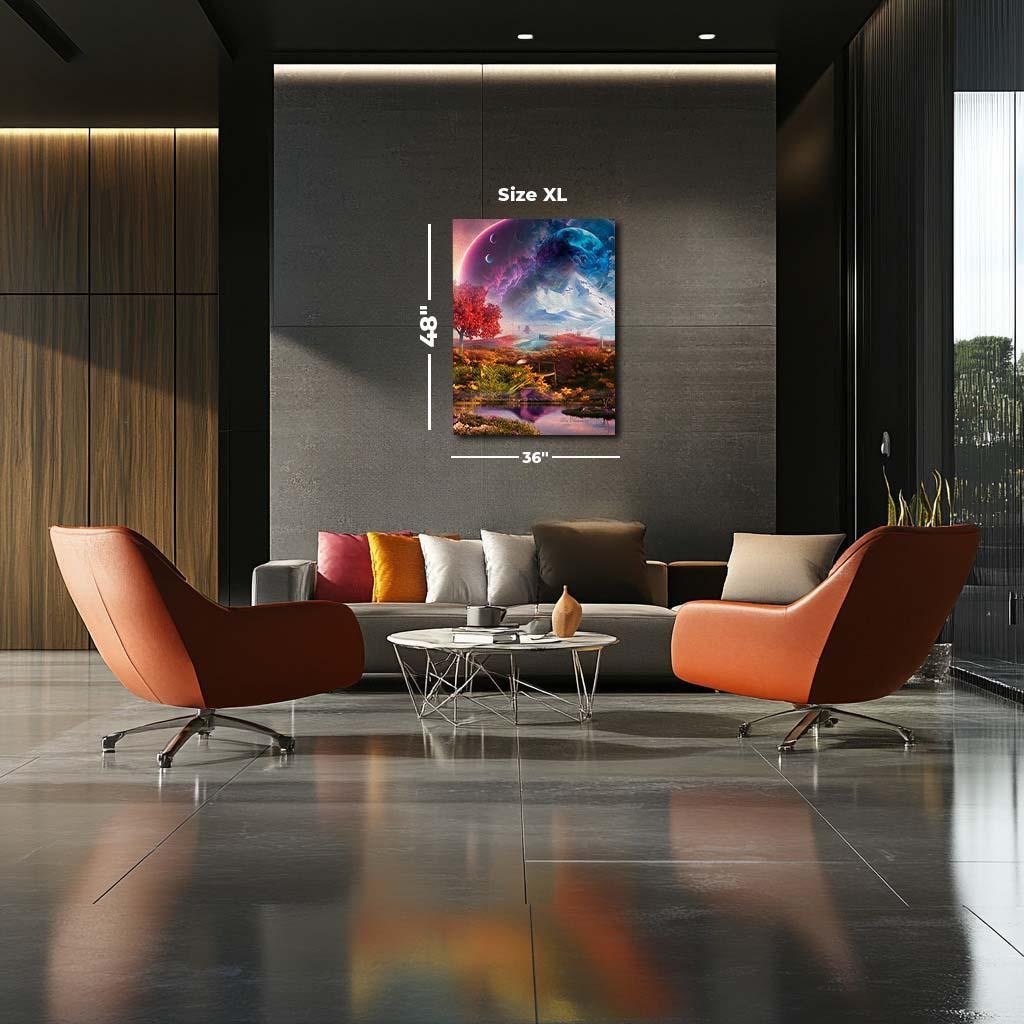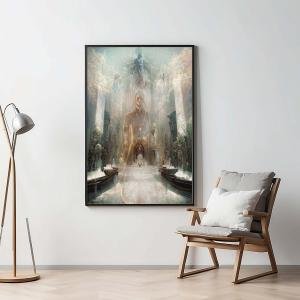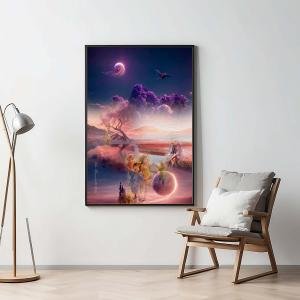The Dance of Seasons and Purpose
"The Dance of Seasons and Purpose" is a visual representation of the powerful verses from Ecclesiastes 3:1-8 , where the Bible poignantly captures the essence of life’s cyclic nature. Every event, every emotion, every action has its time under heaven, and this artwork encapsulates the beauty, struggle, and duality of these moments as they unfold in our lives. The composition is a harmonious blend of colors, symbols, and elements that evoke the eternal rhythm of existence.
Please see Below for Details…
Hotline Order:
Mon - Fri: 07AM - 06PM
404-872-4663
The Cosmic Realms (A Time to Be Born, A Time to Die): At the center of the image, two planets float above the horizon , one in shades of blue and the other in deep purple. The planetary orbs symbolize the opposing forces of birth and death , as they rise and fall in perfect synchrony with one another. The bright light of a sunrise in the far left corner illuminates the red-leafed tree, symbolizing “a time to be born,” while the frozen, snow-covered mountains in the distance depict the “time to die.” These two contrasting landscapes remind us that every beginning has an end, yet each end brings the promise of a new beginning.
Fields of Life (A Time to Plant, A Time to Pluck Up): The vibrant meadows filled with golden flowers serve as a visual metaphor for the “time to plant” —a time of nurturing, cultivating, and growth. Further down the field, the flowers begin to wither, representing the “time to pluck up that which is planted.” Just as the seasons change, so too must we accept that not everything we sow will flourish forever. Sometimes, we must learn when to let go and make space for new growth.
Destruction and Renewal (A Time to Kill, A Time to Heal, A Time to Break Down, A Time to Build Up): On the far right of the artwork, a figure stands at the base of a broken chair , an object that symbolizes the “time to break down.” Above the figure, the ethereal mountains and swirling celestial clouds represent the “time to build up,” a moment where new structures, dreams, and lives take shape after the old has been removed. Just as in life, where moments of destruction lead to healing and rebuilding, the artwork portrays this endless cycle of renewal.
Emotions of the Soul (A Time to Weep, A Time to Laugh, A Time to Mourn, A Time to Dance): The emotional journey is represented by the different figures found within the fields. In one corner, a solitary figure stands weeping , shrouded in shadow, embodying the “time to mourn” and “time to weep.” Across the field, figures joyfully dance and celebrate under a sky filled with vibrant, cosmic hues, symbolizing the “time to laugh” and “time to dance.” This visual duality reminds us that emotions ebb and flow, and both sorrow and joy are necessary parts of the human experience.
Possessions and Release (A Time to Get, A Time to Lose, A Time to Keep, A Time to Cast Away): Beneath the bright red-leafed tree, a chair stands empty , symbolizing a “time to lose” and “time to cast away.” It stands alone in a field of abundance, surrounded by golden flowers and flowing streams, representing the “time to get” and “time to keep.” The image evokes a deep reflection on the material and immaterial things we hold on to in life, whether possessions, relationships, or experiences. There is a time to gather, but also a time to let go.
Speech and Silence (A Time to Speak, A Time to Keep Silence): Toward the background of the artwork, a subtle yet significant division emerges. On one side, figures stand in contemplation , their silence mirrored in the stillness of the snow-covered peaks, representing the “time to keep silence.” On the other side, bright beams of light break through the clouds, symbolizing the “time to speak,” a moment of clarity and action. The artwork suggests that wisdom comes in knowing when to hold back and when to step forward with words.
Love and Conflict (A Time to Love, A Time to Hate, A Time of War, A Time of Peace): Finally, at the heart of the piece, there are two contrasting emotions— love and conflict —represented by the cosmic storm above and the serene landscape below. The storm swirling above the mountains reflects the “time of war” and “time to hate,” where chaos reigns and tensions rise. Yet beneath this storm, the peaceful fields and still waters symbolize the “time to love” and “time of peace,” showing that no matter how tumultuous life becomes, there is always a return to harmony.
The passage from Ecclesiastes 3:1-8 reminds us that everything in life happens for a reason, at the right moment. There are highs and lows, seasons of planting and uprooting, building and breaking down. In human life, this wisdom encourages patience, acceptance, and a deeper understanding of the impermanence of all things. It teaches us that change is inevitable and that by embracing both the joyous and painful moments, we can find a deeper sense of peace and purpose.
This art reflects the delicate balance between opposites, showing that life is not meant to be constant, but rather ever-changing. The passage encourages us to trust in the timing of the universe, knowing that every season—whether of laughter or mourning—has its place in the grander scheme of things. Just as there is a time to speak and a time to keep silent , knowing when to act and when to reflect is essential to finding meaning in our journey under the heavens.
Add your review
Your email address will not be published. Required fields are marked *
Please login to write review!
Looks like there are no reviews yet.








